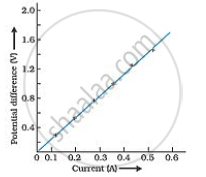Advertisements
Advertisements
प्रश्न
What is an ohmic resistor? Give one example of an ohmic resistor. Draw a graph to show its current voltage relationship. How is the resistance of the resistor determined from this graph?
उत्तर
An ohmic resistor is a resistor that obeys Ohm's law.
For example: all metallic conductors (such as silver, aluminium, copper, iron etc.)

From above graph, resistance is determined in the form of a slope.
APPEARS IN
संबंधित प्रश्न
What will be the change in the current if the potential difference is kept constant and the resistance of the circuit is made four times?
- It will remain unchanged.
- It will become four times.
- It will become one-fourth.
- It will become half.
The graph between V and I for a conductor is a straight line passing through the origin.
What should remain constant in a statement of this law?
How does an increase in the temperature affect the specific resistance of a :
(i) Metal and
(ii) Semiconductor ?
State the limitations of Ohm’s law.
Draw a neat diagram for the verification of Ohm’s law by voltmeter-ammeter method. By another diagram show the relation between p.d. and current.
An ammeter placed in series with an electric radiator reads 0.5 amps and a voltmeter placed across it reads 230 volts. What is the resistance of the radiator?
Define Current density.
Two cells each of 5V are connected in series across an 8Ω resistor and three parallel resistors of 4Ω, 6Ω, and 12Ω. Draw a circuit diagram for the above arrangement. Calculate
- the current drawn from the cell
- current through each resistor
Which of the following I-V graph represents ohmic conductors?
Let the resistance of an electrical device remain constant, while the potential difference across its two ends decreases to one fourth of its initial value. What change will occur in the current through it? State the law which helps us in solving the above stated question.
